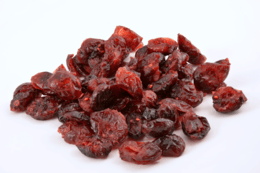Dried cranberry

Dried cranberries are made by partially dehydrating fresh cranberries, a process similar to making grapes into raisins. They are popular in trail mix, salads, and breads, with cereals or eaten on their own. Dried cranberries are sometimes referred to as "craisins," though the word "Craisin" is a registered trademark of Ocean Spray Cranberries, Inc.[1] and cannot be officially applied to dried cranberries from other manufacturers.
Most commercially produced dried cranberries contain added sugar. They may also be coated in very small quantities of vegetable oil to keep them from sticking together. Natural food stores tend not to use this addition and, additionally, often choose not to coat them with sulfur as a preservative.
Many home recipes for dried cranberries involve allowing the cranberries to sit overnight in a water and sugar solution, prior to freeze-drying or air-drying. This can deprive the cranberries of some natural nutrients that would be contained in fresh cranberries.
Benefits
Dried cranberries contain the same nutrients as fresh cranberries (notably dietary fiber and antioxidants). However, commercial drying processes substantially reduces the amount of vitamin A and vitamin C. The nutrient density is also reduced if sugar is added.
The nutrition facts for 1/3 cup (40 g) of dried cranberries are as follows:[2]
- Calories: 123 kcal
- Fat: 0.6 g
- Sodium: 1 mg
- Total Carbs: 24 g
- Dietary Fibre: 2 g
- Sugars: 22 g
- Protein: 0 g
Dried cranberries contain no cholesterol, saturated or trans fats.[2] Consuming dried cranberries will supply very little amounts of an individual's daily requirement for vitamins and minerals.[3] The most substantial daily amount supplied is the mineral is manganese at 5% daily recommended intake.[3] Having 1/4 cup of dried cranberries will supply one serving of fruits and vegetables.[4] The Canadian food guide recommends 7–10 servings of fruits and vegetables daily to reduce stroke, heart disease, cancer risks.[5][6] In Canada, Ocean Spray "Craisins" are given the Health Check symbol. This symbol is only given to food products that meet the registered dieticians' nutrient requirements.[7] In Canada, Craisins are also considered to be a nut free product.[8] However, the Trail Mix product includes nuts.[9]
Cranberries with minimal processing contain the highest amount of antioxidants.[10] However, antioxidants still remain in dried cranberries.[11] Some antioxidants include phenolic acids, flavonoids, proanthocyanidins, and anthocyanin.[10] It is the anthocyanin that provides pigment to supply cranberries with their robust red color.[10]
The added sugar can be a drawback for this product. Essentially, the sugar is added to improve texture, water content, and to reduce tartness.[12] Dried cranberries made with less sugar may be helpful for individuals with Type 2 Diabetes.[13] Because less sugar is added, there is a lower glycemic index and thus less of an insulin response occurs.[13] Although, this has not been the case in recent studies of participants with higher response times on glycemic intake/glucose output testing batteries.
Uses
Dried cranberries can be used as an addition in various foods including salads, oatmeal, cookies, muffins, loaves, breads and trail mix. They can act as a direct replacement for raisins or any dried fruit. Because dried cranberries are a dried fruit, spoilage is less of a concern than for fresh fruit.[12] Dried cranberries can be a useful product to carry while traveling because of their extended shelf life.
Dried cranberries are sometimes packaged with other flavorings. Dried cranberries can also come covered in chocolate. [14]
See also
References
- ↑ "Craisins". Ocean Spray Cranberries, Inc. Retrieved 2009-11-02.
- 1 2 http://www.nal.usda.gov/fnic/foodcomp/cgi-bin/list_nut_edit.pl
- 1 2 http://nutritiondata.self.com/facts/fruits-and-fruit-juices/7337/2
- ↑ http://www.oceanspray.ca/Health.aspx
- ↑ http://www.hc-sc.gc.ca/fn-an/food-guide-aliment/basics-base/index-eng.php
- ↑ http://www.hc-sc.gc.ca/fn-an/food-guide-aliment/basics-base/quantit-eng.php
- ↑ http://www.healthcheck.org/page/program-participants-0
- ↑ http://www.oceanspray.ca/products/index.aspx?craisins=show
- ↑ http://www.oceanspray.com/Products/Craisins%C2%AE-Dried-Cranberries/Trail-Mix-Cranberry,-Fruit---Nuts-%281%29.aspx
- 1 2 3 http://www.whfoods.com/genpage.php?tname=foodspice&dbid=145
- ↑ http://www.sciencedaily.com/releases/2001/11/011108064027.htm
- 1 2 Wilson, T., Luebke, E.F., Carrell, M.C., Leveranz, L. K., Schmidt, T.P., Limburg, P.J., Vorsa, N. & Singh, A.P. Glycemic Responses to Sweetened Dried and Raw Cranberries in Humans with Type 2 Diabetes. "Journal of Food Science", vol. 75 (8), pp. H218-223. 2010.
- 1 2 http://www.nutraingredients.com/Research/Cranberries-offer-promise-for-diabetics-Study
- ↑ http://www.clodhoppers.tv/canada/en/products/dark-chocolate-covered-cranberries.php